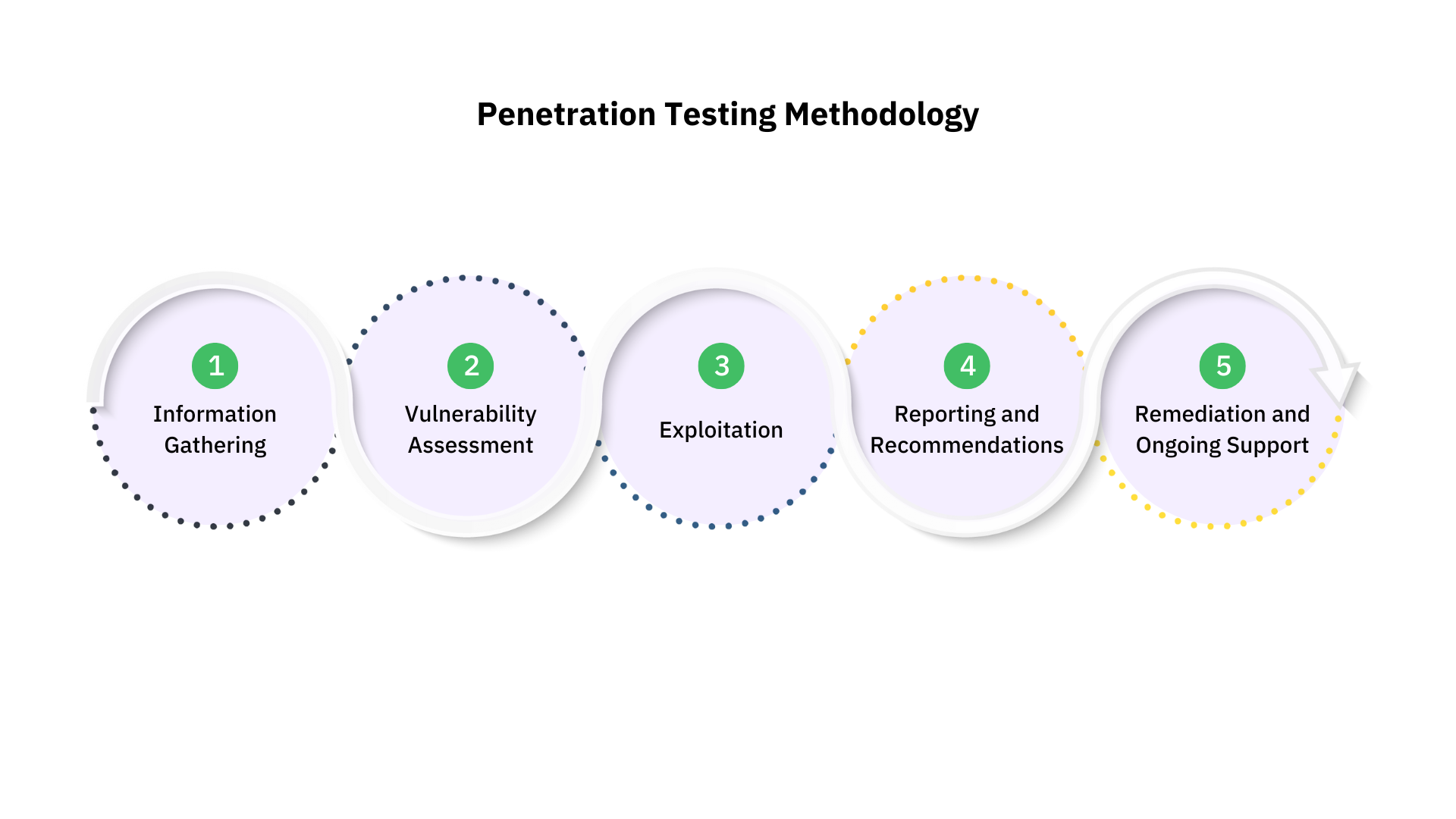In this cyber world, data protection is a main goal for every organization. In India, corporations spend an average of $2.8 million annually on cyber security. According to the ETCISO annual survey, the average security budget allocation to Indian industries is 7.6% of its total IT budget. As compared to previous periods, cyber-attacks have increased in recent years. Every company should concentrate on its data security before the data gets exposed.
As a part of cybersecurity, penetration testing is one of the services used to find vulnerabilities and helps in preventing data breaches. The penetration testing process involves several phases. First the tester gathers information about possible entry points in the server.
Then the tester attempts to breach the security of the tested environment. As part of the final steps of a penetration test, the tester compiles a detailed report outlining the vulnerabilities found and provides suggestions for improving the security of the tested environment.
Penetration Testing Process / Methodology
Penetration testing process involves the following five stages:

- Information Gathering: In penetration testing, information gathering is one of the critical steps of a penetration test. It helps the tester collect relevant and accurate data about the target system, network, or organization. This information is then used to identify potential vulnerabilities and plan further exploitation.
- Vulnerability Assessment: vulnerability assessment is a crucial phase that helps identify potential weaknesses in a target system, network, or organization. This assessment is used to guide further exploitation and provide recommendations for remediation.
- Exploitation: Exploitation is the process of taking advantage of a vulnerability to gain unauthorized access or control over a system. In penetration testing, it’s a critical phase where the identified vulnerabilities are used to compromise the target system.
- Reporting and Recommendations: Reporting and Recommendations is the final phase of a penetration test, where the findings, vulnerabilities, and potential risks are documented and presented to the client. This phase is crucial as it provides the client with actionable insights to improve their security posture.
- Remediation and Ongoing Support: It is a critical component of a comprehensive penetration testing engagement. They ensure that the identified vulnerabilities are addressed effectively and that the organization maintains a strong security posture over time.
By following a comprehensive remediation and ongoing support methodology, organizations can effectively address vulnerabilities, maintain a strong security posture, and protect their valuable assets from cyber threats.
Different Types of Penetration Testing:
In penetration testing, we almost cover all types of testing. Here are some of the popular ones –
Application Security Penetration Testing:
Application Security Penetration Testing (Pentesting) is a security assessment process aimed at identifying vulnerabilities, weaknesses, and security gaps within an application. This type of testing simulates real-world attacks on an application to evaluate its security posture and determine how well it can withstand various cyber threats. This pentesting is further classified into three types.
- Web Application Pentesting: Web Application Penetration Testing is a security evaluation process focused on identifying, exploiting, and reporting vulnerabilities in web applications. The primary goal is to discover security flaws that could be exploited by attackers to compromise the application, steal data, or disrupt services.
- Mobile Application Pentesting: Mobile Application Penetration Testing is a security assessment process focused on identifying and exploiting vulnerabilities within mobile applications to ensure their resilience against cyber threats. This testing involves examining the application, its backend systems, APIs, and interactions with mobile operating systems to uncover security weaknesses that could be exploited by attackers.
- API Pentesting: API Penetration Testing focuses on identifying vulnerabilities within Application Programming Interfaces (APIs) to ensure they are secure against unauthorized access, data breaches, and other cyber threats.
APIs are critical components of modern applications, facilitating communication between different software systems, and are often targeted by attackers due to their accessibility and direct interaction with backend services.
Network Security:
Network Security refers to the strategies, policies, and practices designed to protect a computer network and its data from unauthorized access, misuse, malfunction, modification, destruction, or improper disclosure. It involves implementing both hardware and software technologies to safeguard the integrity, confidentiality, and availability of the network and the data transmitted through it. In this service we offer two types of network security services they are
- Internal Network Pentesting: Internal Network pentesting (or Internal Network Pentesting) is a security assessment method focused on identifying vulnerabilities and potential attack vectors within an organization’s internal network.
Unlike external pentesting, which targets an organization’s perimeter of the security, internal pentesting simulates an attack from within the network, compromised user accounts, or malicious actors who have breached external security standerds. - External Network Pentesting: External Network pentesting (or External Pentesting) is a type of security assessment focused on evaluating the security of an organization’s external-facing infrastructure, such as websites, servers, and network services that are accessible from the internet. This testing simulates attacks that could be carried out by external threat actors, including hackers and cybercriminals, to identify vulnerabilities that could be exploited to gain unauthorized access.
Cloud Security:
Cloud security is a critical aspect of modern IT infrastructure. It involves implementing technologies, policies, and controls to safeguard data, applications, and infrastructure hosted in the cloud. By addressing threats like cyberattacks, data breaches, unauthorized access, and other risks, cloud security ensures the confidentiality, integrity, and availability of cloud resources.
While 37% of companies prioritize proper cloud security configuration from the outset, there is still room for improvement. To assist in this regard, we offer specialized pentesting services for popular cloud platforms like AWS, Azure, and GCP. These services help identify vulnerabilities and potential security threats within your cloud environment.
This security services is further classified into two categories they are:
- Cloud Infrastructure Pentesting: Cloud Infrastructure Pentesting is the process of systematically testing and evaluating the security of a cloud environment by simulating real-world cyberattacks. The goal is to identify vulnerabilities, misconfigurations, and security weaknesses within cloud infrastructure components like virtual machines, storage, networks, and cloud management services.
- Cloud Configuration Review: A Cloud Configuration Review is a comprehensive assessment of cloud infrastructure settings and configurations to ensure they attach to security best practices, compliance standards, and organizational policies. The primary goal is to identify and rectify misconfigurations, which are a common cause of cloud security incidents, such as unauthorized access, data breaches, and compliance failures.
- Breach & Attack Simulation:
Breach & Attack Simulation (BAS) is a cybersecurity technology that allows organizations to simulate real-world cyber attacks in a controlled environment to evaluate their security posture. BAS tools continuously test the effectiveness of security controls by mimicking tactics, techniques, and procedures (TTPs) used by cyber attackers. In this breach attack simulation includes,
- Red Teaming: This red team testing involves a team of ethical hackers (known as the Red Team) to simulate advanced, persistent threats against an organization’s protection. This exercise goes beyond automated simulations by employing human-driven tactics that closely mimic the strategies of real-world adversaries.
- Assumed Breach: It is a security testing approach where the simulation starts with the assumption that an attacker has already breached the perimeter of an organization. Instead of focusing on how attackers get in, this method zeroes in on what they can do once inside the network. This approach emphasizes testing the internal security measures, lateral movement, data access, and the organization’s detection and response capabilities.
Benefits Of Penetration Testing Process
- Improved Security Posture: Pentesting helps identify vulnerabilities and weaknesses in an organization’s security posture, enabling them to take corrective actions and strengthen their security measures.
- Reduced Risk of Data Breaches: By simulating real-world attacks, pentests can uncover potential entry points for attackers, allowing organizations to patch or remediate these vulnerabilities before a breach occurs.
- Compliance with Regulations: Many regulatory frameworks, such as PCI-DSS and HIPAA, require regular security assessments, including penetration testing. Pentesting helps ensure compliance with these regulations.
- Cost Savings: Identifying and addressing security weaknesses early on can prevent costly data breaches or other security incidents that may damage an organization’s reputation and bottom line.
- Increased Confidence in Security Measures: A successful pentest report provides assurance that an organization’s security controls are effective, giving stakeholders confidence in the overall security posture of the organization.
- Identification of High-Risk Vulnerabilities: Pentests can help prioritize remediation efforts by identifying high-risk vulnerabilities that require immediate attention.
- Improved Incident Response Planning: By simulating attacks, pentests can help organizations develop effective incident response plans, ensuring they are prepared to respond quickly and effectively in case of a security incident.
- Enhanced Security Awareness: Pentests educate employees, management, and other stakeholders about security best practices, vulnerabilities, and potential attack vectors.
- Reducing Overhead Costs of Security Measures: Identifying unnecessary or redundant security controls through pentesting can help reduce operational overhead costs associated with implementing and maintaining these measures.
- Better Alignment with Business Needs: By integrating pentesting into the development process, organizations can ensure that security requirements are considered alongside business needs, leading to more effective security measures.
How does Pentesting Platform help in Penetration Testing Process?
Pentesting tools are also known as vulnerability management tools. These tools are essentials for streamlining and automating many aspects of the pentest process. Here are some key ways in which pentesting platforms assist in the pentest process:
Automation Of Tasks:
Automation of tasks is one of the core benefits of using pen testing platforms. By automating routine and repetitive tasks, security professionals can significantly improve efficiency, reduce human error, and focus on more strategic activities.
Here’s a breakdown of the key areas where automation is particularly valuable:
- Vulnerability scanning: These platforms can quickly scan for vulnerabilities, networks, and applications for known vulnerabilities, saving significant time.
- Exploit testing: Some platforms can even automate the testing of vulnerabilities to determine if they can be exploited.
- Reporting: Many platforms generate detailed reports, including findings, recommendations, and evidence, simplifying the communication of results.
Centralized Management:
Centralized management is another key feature of pentesting platforms that enhances efficiency and organization. By providing a single, unified interface for managing various aspects of the pentest process, these platforms enable security teams to maintain better control and visibility.
Here are some key aspects of centralized management:
- Project management: Pentesting platforms often provide tools for managing projects, including scheduling tasks, assigning responsibilities, and tracking progress.
- Asset management: They can help in inventorying assets, such as servers, networks, and applications, making it easier to prioritize testing.
Integration with Other Tools:
Here’s a breakdown of some key integration points:
Pentesting platforms often offer robust integration capabilities, allowing them to seamlessly work alongside other security tools and systems. This integration enhances the overall effectiveness and efficiency of security assessments by providing a more comprehensive view of the security.
- Security information and event management (SIEM): Platforms can integrate with SIEM systems to correlate findings with other security events.
- Ticketing systems: They can automatically create tickets for identified vulnerabilities, streamlining the remediation process.
Enhanced Efficiency:
Pentesting platforms offer significant improvements in efficiency, allowing security teams to conduct assessments more quickly and effectively. Here’s a breakdown of how enhanced efficiency is achieved:
- Faster testing: Automation and streamlined workflows allow for more rapid assessments.
- Improved accuracy: Platforms can help reduce human error by automating repetitive tasks.
- Scalability: They can handle large-scale assessments, making them suitable for organizations of all sizes.
Knowledge Base and Best Practices:
Pentesting platforms often incorporate a comprehensive knowledge base and best practices to enhance the effectiveness of security assessments. These resources provide valuable information and guidance to security professionals, helping them make informed decisions and improve their skills.
- Built-in knowledge: Many platforms include a knowledge base with information on common vulnerabilities and best practices.
- Community support: Some platforms have active communities where users can share insights and collaborate.
Final Words
Protecting company data has become an absolute necessity for organizations worldwide, underscoring the need for robust security measures to mitigate these threats. Strobes offers an innovative solution aligned with proven pentesting steps to address this pressing concern.
Our platform enables you to perform on-demand or recurring pen-tests from anywhere and at any time, ensuring that your organization’s security posture is continuously evaluated and strengthened. Don’t wait until it’s too late! Schedule a demo with us to experience the benefits of Strobes for yourself.
Frequently Asked Questions (FAQs)
Q.1 What is the purpose of the penetration testing process?
The penetration testing process determines if systems, applications, or networks are vulnerable to cyberattacks by simulating real-world adversary tactics. This proactive approach identifies gaps that standard security controls might overlook, enabling prioritized remediation.
Q.2 How does penetration testing ensure data security?
Penetration testing systematically uncovers weaknesses throughout infrastructure and applications, allowing organizations to fix vulnerabilities before they are exploited. This strengthens defenses and helps protect sensitive data from unauthorized access.
Q.3 How often should penetration testing be performed?
Penetration tests are typically scheduled annually or after major changes to the network or application infrastructure. For regulated industries, compliance standards may require more frequent testing depending on system criticality.
Q.4 What is grey box penetration testing?
Grey box penetration testing is a security assessment where testers have limited knowledge of the target system, such as login credentials or system architecture, but not full access. It combines elements of black box and white box testing to provide a more efficient and focused evaluation. This approach simulates an attacker who has some insider information or has breached initial defenses. It helps identify vulnerabilities with better precision than black box testing, while being less resource-intensive than white box testing
Q.5 What is the difference between Vulnerability Assessment and Penetration Testing?
Vulnerability Assessment identifies and prioritizes security weaknesses in systems using automated tools, providing a broad view of potential risks without actively exploiting them. Penetration Testing takes this further by simulating real-world cyberattacks to actively exploit vulnerabilities and assess their actual impact on security. While vulnerability assessments are quicker and less costly, penetration tests provide deeper insights into how vulnerabilities can be used to compromise systems. Both are essential, complementary practices for comprehensive security risk management and compliance.
Q.6 What are the measurable business benefits of the penetration testing process?
Penetration testing enables organizations to prevent costly incidents by uncovering exploitable vulnerabilities before bad actors do, reducing both breach risk and the likelihood of fines from regulatory non-compliance. It also helps avoid brand damage and operational downtime, which can result in significant savings relative to the cost of testing annual security budgets.
Q.7 How does penetration testing impact ROI and cost management?
The return on investment of penetration testing is demonstrated by the ability to avert direct losses from incidents, reduce legal liabilities, and avoid regulatory penalties. Organizations can quantify ROI by comparing the cost of remediation after a simulated breach against potential damages if a real incident were to occur.








